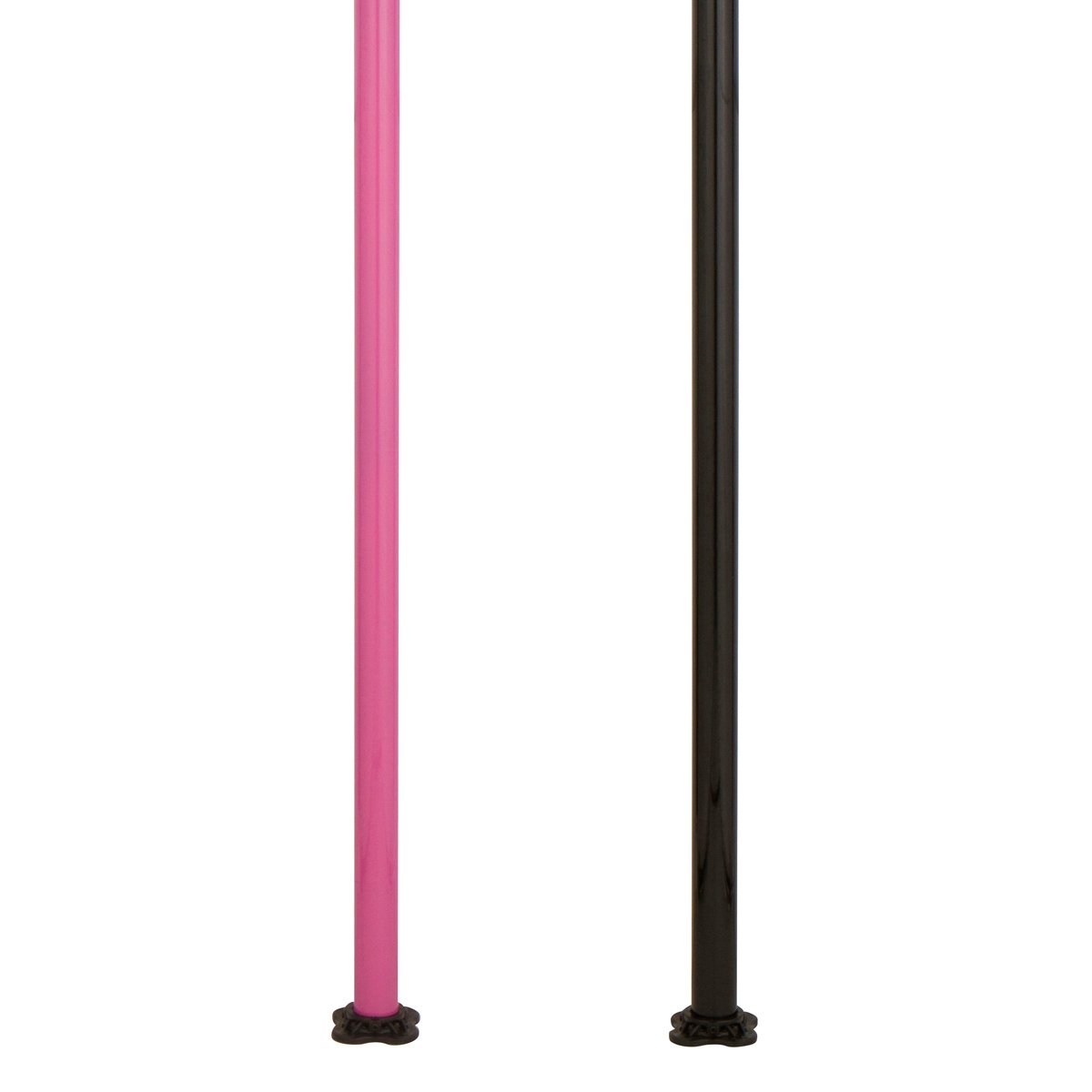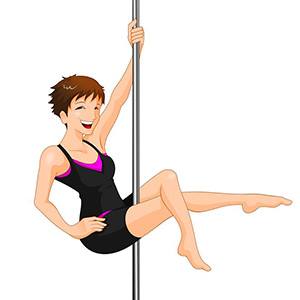- Home
- FAQ
- Plus Size Pole Dancing FAQ
- Best Pole for Plus Size
What's the Best Pole for Plus Size Pole Dancers?
I'm 300 pounds. Which type of pole is best, and which brand can hold my weight?
~ Shelly
This page may contain affiliate links. If you make a purchase through one of these links, Your Pole Pal may receive a small commission (at no cost to you). And that helps ensure this site stays online and free for everyone. Learn more.
Plus size pole dancers, rejoice! You can join in the fun AND feel safe and confident on your dance pole.
 Plus size pole dancers, rejoice!
Plus size pole dancers, rejoice!Introduction
Lots of new polers have general questions about the different dance poles available today, and which one is best for their needs. Often, the deciding factor is portability, installation method, or choice of color or material.
But for many plus size people who want to buy a dance pole for home use, the most pressing concerns are around the safety of the different poles available, particularly in regards to weight limits.
This page is filled with information to help address one of the most common questions among plus size polers: of all the choices available today, which is the best pole for plus size pole dancers?
We'll examine a number of factors that affect pole strength and stability, as this is what really matters when it comes to how much weight a given pole can safely support. We'll also look at a couple of other considerations plus size pole dancers might want to think about as they compare the options.
Finally, we'll wrap up with a comparison chart that provide an at-a-glance summary of how the various types of pole stack up, and also which companies offer each type of dance pole.
Your Pole Pal aims to provide reliable information to help you decide on the best pole for plus size YOU.
In This Article...
Factors that affect pole strength:
Factors that affect stability:
Other considerations:
Comparison chart:
Pole Strength
Pole Wall Thickness
The first thing to know when addressing concerns about pole strength, is the thickness of the metal used to construct the pole. We're not talking about diameter here, but rather the thickness of the wall of the metal tubing.
Good quality poles like the Lil Mynx or the XPole will typically have a thicker pole wall than some of the knockoff brands. Thinner tubing is cheaper, which brings the price of the pole down, but it won't take as much of a load as a pole made from a thicker walled tubing.
Most people don't consider this when shopping around, and it's not normally obvious just from a casual inspection. Also - unlike pole diameter, length and material - pole wall thickness isn't usually mentioned in the specs when you're shopping online. But plus size pole dancers who are at all concerned about the weight limits of the different dance poles should definitely consider this.
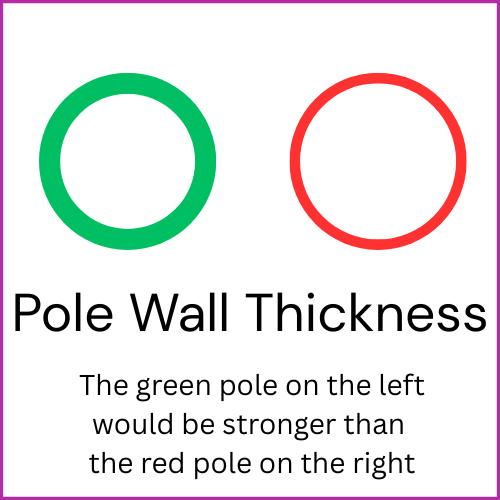
Many of the cheaper models available, particularly some of the knockoffs made offshore, cut corners by using metal tubing with a thinner wall. Stay away from these if you're concerned about maximum safety and strength, as they are not going to take the same weight load as a higher quality product with a thicker wall.
Pole Diameter
The standard dance pole diameter used to be 2" (50 mm), but most manufacturers now offer at least one smaller diameter pole. Most of these are 1.75" (45 mm) but we're now seeing more poles available in a 1.5" (40 mm) diameter model too.
The smaller diameter (usually 1.75") is now being used as the standard in pole dance competition, and many contests and events specify this size. Partly for this reason, and partly because the 1.75" size is a better fit for many women's hands, more and more women are finding they prefer this smaller diameter option.
However, be aware that the smaller the diameter, the less strong the pole will be overall.
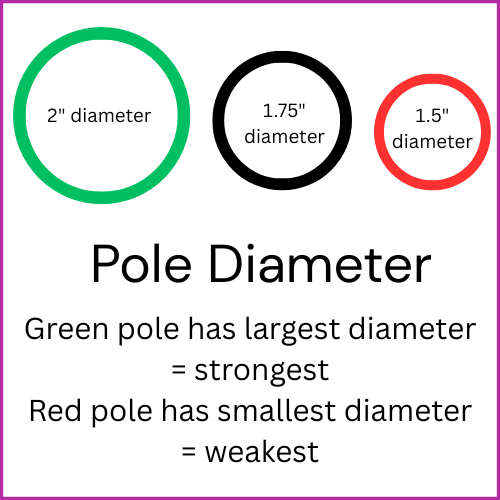
Depending on your weight and how you intend to use your dance pole - for airborne tricks or strictly for floor-based moves - this may not be the make-or-break factor. Particularly if your hands are small, you may find that you just can't get a good grip on a larger diameter pole.
It's good to keep in mind though, that all other things being equal, the safe weight load of a thicker diameter pole is going to be higher.
Type of Material
The type of material used in the construction of your dance pole will also affect its strength. For example, brass is an alloy (mixture) of copper and zinc, and is a softer metal than stainless steel, so a brass pole will be inherently weaker than one made of stainless steel.
That's not to say that a brass pole isn't strong, just that relatively speaking, it's not the strongest alloy. Consider that steel has iron as its base (stainless steel, from which many dance poles are made, is an alloy of iron and chromium).
Steel also has a higher tensile strength than brass. The higher the tensile strength, the greater the ability to withstand a force.
Be aware that there are some so-called "brass" models on the market that are not actually brass, but rather a brass look-a-like. Typically, these are plated steel and are therefore stronger than brass (though the durability of the coating is something else to consider again).
You can usually spot these imitation brass poles because the cost is much less than what you would expect to pay for brass. Not that there's anything wrong with them, however remember the rule of "buyer beware." It's up to you as the buyer to be sure you're getting what you think you're getting!
So if you have your heart set on a brass pole, be sure to ask if it's real brass before you buy. And if you're wanting to avoid brass in order to go with a stronger material, well you'll still want to ask, right?
In addition to brass, stainless steel, and plated steel (i.e. chrome), there are also dance poles made of powder coated steel.
Lil Mynx sells powder coated steel poles in two colors and in both rotating and static models. Because steel is the base metal, they're going to be a stronger option than brass as well.
Keep in mind that all materials have their advantages and disadvantages, and many people also have a personal preference for say, brass over steel, or a powder coated finish over brass.
It's also important to remember that the properties of the different materials that dance poles are made of is just one factor in choosing the best pole for plus size polers. Everyone has different preferences and priorities, so it's important to look at all the factors that come into play.
Let's continue our investigation...
One Piece vs Multi-Piece (Portable)
Another very important decision that plus size pole dancers will need to make is whether to get a one piece or a multi-piece dance pole. Multi-piece poles are typically billed as "portable poles" because they come apart, usually include a carrying case, and can easily be moved from place to place.
When considering pole strength however, it's important to know that the more seams and joints there are in a given pole, the weaker the overall construction will be.
This is because a solid, unbroken length of tubing has greater structural integrity than one that is made up of several pieces, and is therefore stronger.
So all other things being equal, a one piece pole is going to be stronger than a multi-piece pole. The key phrase here is "all other things being equal." To review our earlier discussion, it's possible that a multi-piece 2" brass pole with a thicker wall might actually be stronger than a one piece 1.5" steel pole with a slightly thinner wall.
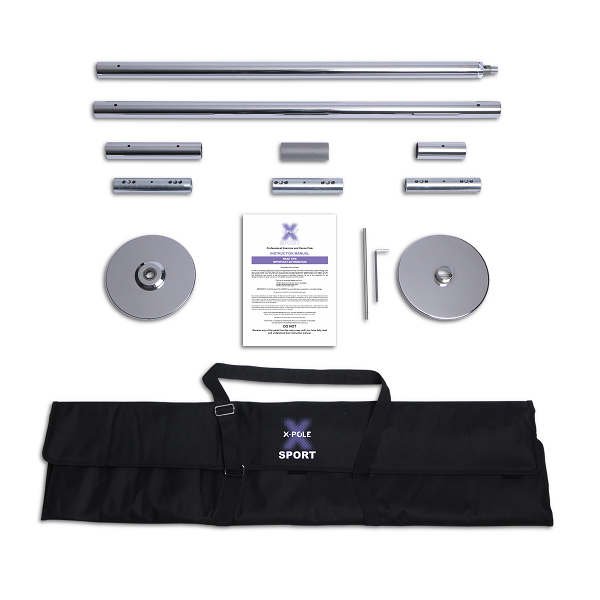 This X-Pole is an example of a multi-piece pole
This X-Pole is an example of a multi-piece poleAnd just to make matters more confusing, let's also consider the height of the pole. The longer the length of tubing in general, the weaker it will be. This means that an 8' multi-piece pole could potentially be stronger than a 10' one-piece pole (depending on other factors discussed above, such as the number of seams, thickness of the tubing, and the material used).
Also, consider how the pole goes together. A multi-piece model with solid joints that screw together is going to be heavier, but certainly stronger than one that simply slides or snaps together.
Are you starting to see that this discussion is a bit more complicated than it appears at first glance?!
Pole Stability
Installation Method
Many people don't consider installation method when trying to figure out which is the best pole for a plus size pole dancer. But how a dance pole is installed has a lot to do with its ability to stay vertical, especially under load.
A permanently mounted pole is by far the most secure because it's screwed into both the floor and ceilings joists. Because of this, its ability to withstand a given weight load is very high.
Despite their high safety rating and weight limit however, permanent poles are not the solution for everyone. If you want to be able to take your pole down, or move it to another location, having it screwed into your floor and ceiling can be a real pain.
On the other end of the scale, a friction fit (or pressure mount) dance pole is the least secure in terms of installation, and accordingly, it would typically have a lower safe weight limit.
It isn't that a friction fit pole is inherently weaker, it's the mounting system. This type of pole is extended to fit the ceiling height, and then relies on pressure, as well as "grippy" floor and ceiling plates, to stay in place. Friction mount poles are more prone to coming down, regardless of the weight load, simply by virtue of their design.
For a more detailed explanation, you can read more about friction fit pole safety here.
An excellent compromise, in Your Pole Pal's opinion, is a semi-permanent or removable type of dance pole. This type of pole does not rely on a friction mount at the ceiling, but instead uses a small mount that the pole either fits over, or into. This mount is screwed into a ceiling joist and remains in place, but the pole can be put up and taken down very easily once the mount is installed.
A removable dance pole still uses pressure to stay in place, but the permanent ceiling mount offers much greater safety and stability than a friction mounted pole, with the same ease of installation and removal.
Previously Lil Mynx was the only company that manufactured this type of dance pole, and they still have a patent on their unique design that involves a relatively small mount that is installed with a single lag bolt.
But other companies like XPole are now making permanent ceiling mounts for use with their friction fit poles, to convert them into removable or semi-permanent dance poles. These mounts are screwed into the ceiling and stay in place. The formerly friction mounted pole is then inserted into this mount (without the friction pad of course) and it then becomes a much more secure semi-permanent pole.
To complete the discussion, portable (multi-piece) dance poles also use a pressure mounted system, so for the purposes of comparing installation methods, portable poles can be considered in the same category as friction mount poles. Of course, these poles are also convertible to semi-permanent poles by using a permanent ceiling mount.
Other Considerations
In addition to the five factors discussed above, here are a couple of other things plus size pole dancers may wish to consider when deciding on the best pole for home use.
Reinforcement
If you are considering a smaller diameter pole, especially if you feel it's your only real choice because you have small hands, there is the option to have the pole reinforced. This is only possible with a permanently mounted pole mind you, but it's an important factor worth considering.
Reinforcement is most likely to be needed with a very small diameter model (1.5"). Also, the longer your pole, the better idea it is to have it reinforced.
To provide this extra reinforcement, a solid steel rod slightly smaller than the diameter of your pole is inserted into the hollow outer tube before installation, providing additional strength and stability.
If you're purchasing a permanent dance pole, you can ask the manufacturer about supplying a solid reinforcement for the interior. X-Pole currently provides this option, though it is geared towards studios and competitions so you may need to ask about it.
If reinforcement isn't possible with the pole you're considering, or if the shipping cost is prohibitive (it will be heavy!), you may be able to purchase a length of solid steel tubing from a local metal supply shop or hardware store and install it into your permanent pole yourself.
Ease Of Installation
Something else for plus size pole dancers to consider is whether or not you're going to be able to do the installation on your own if necessary.
That's not to imply that plus size women lack strength. In fact, chances are you may be stronger than average. After all, if you're carrying extra weight, at least some of it is probably muscle, right?
It's just that sometimes, carrying extra weight comes with associated issues like joint disease or chronic back pain, which can hamper your ability to properly assemble and install your pole. For this reason, it's important to consider what type and brand might best meet any special needs or health concerns you have that are related to your weight.
For instance, a permanent pole only needs to be installed once. Even if you need a friend or family member to help you with the installation, once it's done it's done, and you won't need to worry about it again except for occasionally checking that all the screws are good and tight.
On the other hand, a friction fit model or a removable dance pole needs a bit more attention, even if you plan to leave it up for a period of time.
For example, you really should be doing regular load tests on these types of poles, and you'll also need to get up on a ladder to check it for tightness, preferably before every use. And if/when your pole does become loose, you'll need to be able to adjust and tighten it so it's safe once again.
Stated Weight Limits
This is a tricky one. It would be so easy if companies that make poles would just rate them for weight limits. That way, plus size polers would have a much easier time choosing their best dance pole.
Some companies do provide guidance, but most are rather vague about what the maximum weight is for their dance poles. Or the information is buried somewhere deep in their website. And when a pole manufacturer does give a weight limit, it's usually well inside a very wide margin of safety. Why? Mostly for legal reasons.
Most dance pole companies that do state the maximum weight of their dance poles come in at around the 200 lb mark. Even if they use a very strong steel, even if their poles have been designed by a structural engineer, and even if they've been scientifically load tested, they're generally going to be ultra-conservative and give an official weight limit that's much lower that what they consider the maximum to be.
And can you blame them? Especially in the USA, where litigation is practically a national pastime, dance pole manufacturers need to protect themselves from lawsuits.
Now, Your Pole Pal is certainly not going to tell you to disregard a manufacturer's stated weight limit for their dance poles. After all, you have to be able to start somewhere. And those poles that are not meant for weight bearing moves like climbs and spins should state that in their marketing materials. To imply otherwise would almost certainly be seen as negligent.
But given the reality that most pole manufacturers are not going to state publicly that their pole can handle 3-400 lbs of spinning weight for example, it's critical that plus size pole dancers understand the factors that contribute to pole strength, stability and reliability. This knowledge is critical to making your own informed decision about whether a particular pole seems to be a good choice for plus size polers, or is not worth your time.
So What's The Very Best Pole For Plus Size Pole Dancers?
As you may have guessed by now, when it comes to choosing the best pole for plus size polers, there's no one-size-fits-all answer.
Naming one pole as "the best" plus size pole wouldn't be honest, since in addition to concerns about weight limits, plus size polers also have other needs and preferences that are unique to them. To ignore these is to assume all plus size pole dancers are the same, which certainly isn't the case.
For example, if you feel that a permanent dance pole is your best option safety-wise, but you really want the convenience of a multi-piece portable model so you can take it with you to your Summer cottage, you'll need to consider whether the flexibility advantages of the portable pole outweigh the safety advantages of the permanent pole.
Ultimately, the best pole for plus size YOU is the one that you feel will meet your needs for safety, as well as whatever other factors are important to you, such as flexibility or portability for example.
Following is a chart that might help you make that decision. The different types of poles are compared based on stability, strength and ease of installation...more ✅ means a higher (better) rating for that factor.
Keep in mind that these are necessarily somewhat general comparisons. As discussed above, factors like pole diameter, material, and pole length also play a role in pole strength and stability, but these are not specific to any one type of dance pole.
You'll also see which of the top pole brands sells that type of pole. Where possible, links take you directly to that type of pole on the manufacturer's website, so you don't have to search through their entire catalog of poles and accessories to find it.
Pole Types - Comparison Chart
Permanent Pole
Inserted into mounts that are screwed into both floor and ceiling
🏗️ Stability: ✅✅✅✅
💪 Strength: ✅✅✅✅
🔧 Ease of Installation: ✅ (installation required only once)
🛒 Brands to shop: Lil Mynx, Lupit Pole (both ship worldwide)
Removable or Semi-Permanent Pole
Inserted into a permanently installed ceiling mount, uses a floor pad at the base
🏗️ Stability: ✅✅✅
💪 Strength: ✅✅✅
🔧 Ease of Installation: ✅✅✅ (after initial installation of ceiling mount)
🛒 Brands to shop: Lil Mynx (worldwide), Lupit Pole (worldwide), X-Pole USA, X-Pole Canada, X-Pole Mexico, or X-Pole UK (ships to all other countries) NOTE: X-Pole functions as a semi-permanent pole only when installed using the optional permanent mount)
Friction Mount/Portable Pole
Pressure mounted pole (one or multi-piece) that uses friction pads for floor and ceiling mounts
🏗️ Stability: ✅✅✅
💪 Strength: ✅✅
🔧 Ease of Installation: ✅✅
🛒 Brands to shop: Lupit Pole (worldwide), Mipole (worldwide), X-Pole USA, X-Pole Canada, X-Pole Mexico, X-Pole UK (ships to all other countries)
🔍 Notes:
🏗️ Stability: how solid the pole feels during spins, climbs, inversions or any move that generates force (somewhat subjective).
💪 Strength: considers the type of mounting system, single or multi-piece, and the recommended weight limit, if stated (a more objective assessment).
🔧 Ease of Installation: how quickly and easily the pole can be put up and taken down, taking into account assembly if required.
Summary
As a plus size pole dancer you CAN enjoy this fun and exciting form of fitness. Choosing the best pole will require a bit of research, but that's the case for anyone, not just plus size people who want to pole.
You'll want to carefully consider the pros and cons of each of the 3 major pole types discussed on this page (permanent, removable and friction mount), as well as factors such as the material the pole is made of, and the length and diameter of the pole.
Of course your weight is an important factor in the equation, but only you can decide which pole type and brand gives you the most confidence in that regard. And remember to give some thought to your preferences, priorities and abilities too, so you'll feel confident about the equipment you purchase as a whole, not just in terms of weight limit.
Ultimately, taking the time to do your own research will allow you to make a truly informed decision. And that will yield much better results than seeking a short answer to the question of which is the best pole for plus size pole dancers. Because every plus size pole dancer is unique.
Your Pole Pal hopes that, armed with the information in this article, you'll be able to make the choice that's best for YOU.
What's New?
-
UK Pole Dancing - Scotland
Jan 13, 26 05:09 PM
Looking for UK pole dancing in Scotland? This directory of studios will help you find pole classes in your area. -
Find Colorado Pole Dancing Classes
Oct 31, 25 02:44 PM
Searching for Colorado pole dancing opportunities? Come on in and let us help you find a class near you with our free directory. -
Plus Size Dance Pole Guide - Top Poles with Higher Weight Limits
Jul 31, 25 03:03 PM
What's the best plus size dance pole? Not all poles are created equal. Find out which brands support higher weight limits, and which ones to avoid. -
Pole Dance Studios in Brazil | Global Pole Directory
Jul 26, 25 04:55 PM
Explore pole dance studios and instructors across Brazil. Find pole fitness classes for all levels and styles with the Brazil pole dancing directory. -
Pole Fitness in Hawaii | Worldwide Pole Dance Directory
Jul 14, 25 11:39 PM
Searching for pole fitness in Hawaii? Look no further! Discover pole studios and instructors across Hawaii and start your pole dance fitness adventure today! .
Your Pole Pal loves to have fun, but she also has to earn a living, right? That's why you'll see ads on this site. She may also earn commissions on some of the products you'll see here, but there's never any cost to you since the advertisers pay for these.
The income generated through these means helps ensure Your Pole Pal can devote the time to providing you with all the free and fabulous information & resources you'll find on this website.
Want to learn more? Your Pole Pal invites to you read her full advertising disclosure. You know...in case you haven't read enough legalese lately.

